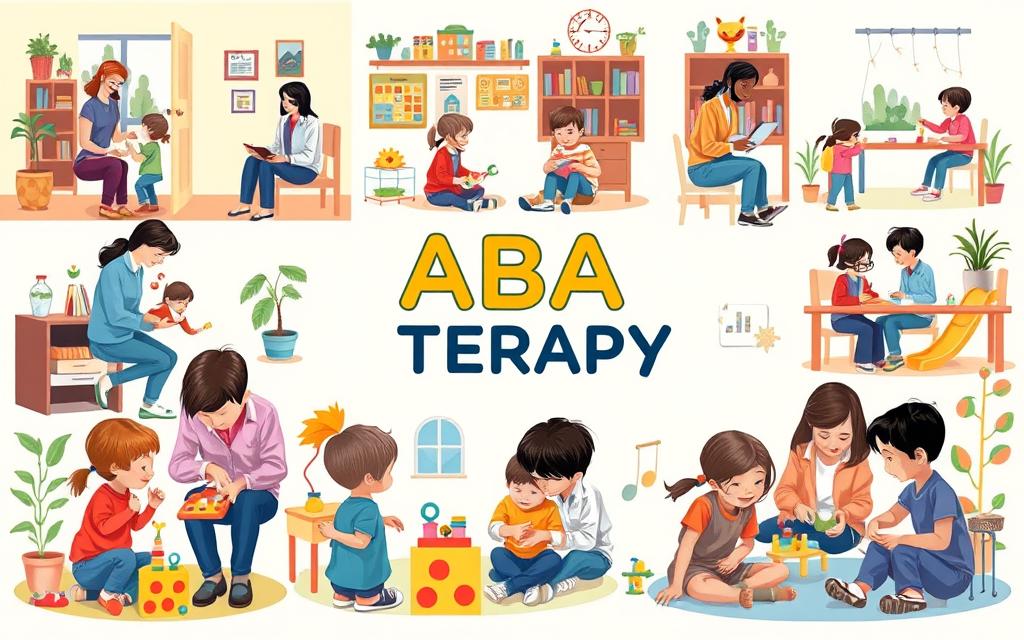Mastering ABA Therapy: Essential Techniques for 2025
The challenge of autism spectrum disorder (ASD) needs smart solutions by 2025. ABA therapy techniques will change to meet the needs of evidence-based behavior interventions. This shift aims to boost treatment effectiveness. It uses the latest research and tech innovations. For the 1 in 44 children with ASD1, this brings hope. Innovations like Virtual Reality can make learning new skills easier. This could greatly change how effective ABA therapy is by 2025.
Key Takeaways
- Understanding of ABA therapy as an evidence-based approach essential for effective autism treatment strategies.
- Adoption of cutting-edge technologies such as VR and mobile apps to enhance traditional ABA methods.
- Recognition of the necessity for individualized treatment plans, with promising outcomes reported in communication skill development1.
- Commitment to rigorous training and ethical application by behavior analysts for improved intervention quality.
- Encouragement of family involvement in therapeutic practices for a cohesive care strategy that extends beyond the therapist’s office.
- The role of continuous data analysis in tailoring ABA interventions to track and optimize progress effectively1.
- An outlook on accessibility, advocating for broad dissemination of advancements to meet the growing demand for autism services2.
Stay tuned for insights at www.londonspd.com/blog/.
Understanding ABA Therapy Fundamentals
Applied behavior analysis (ABA) therapy is recognized by the U.S. Surgeon General and the American Psychiatric Association. It is crucial in treating autism spectrum disorder (ASD). This proves its acceptance and credibility3.
Definition of ABA Therapy
ABA therapy uses research-based methods to help improve social, communication, and learning skills. It involves structured interventions and positive rewards. The therapy identifies why certain behaviors happen and creates ways to change them for the better34.
Historical Context and Evolution
ABA started in the 1960s and has changed a lot since then. Techniques like Discrete Trial Training (DTT) and the Picture Exchange Communication System (PECS) help improve communication and daily skills. They make learning new skills faster and make daily tasks easier4.
Importance of Evidence-Based Practices
ABA’s success is backed by solid data. Tools like the VB-MAPP, ABLLS-R, and AFLS track progress and refine treatments every six months3. ABA does not only help kids with ASD. It also benefits those with ADHD, OCD, and more, showing its wide range and effectiveness3. Yet, everyone’s needs are unique, requiring personalized plans by certified analysts5. These plans follow seven key ABA principles for a comprehensive and targeted approach5.
The Role of Behavior Analysts in 2025
By 2025, the field of Applied Behavior Analysis (ABA) will see big changes. New methods in behavior modification and cognitive therapy will lead the change. Behavior analysts will need better skills and ethical standards to help more people.
Qualifications and Training
Soon, there will be a big need for skilled behavior analysts6. The job outlook is shooting up by 22% from 2020 to 2030. This is mainly for those working with autism. Training will cover basics and advanced techniques like early help and changing adult behaviors. Using ABA in schools has already made learning better by 50%6.
Ethical Considerations
ABA pros must care for clients with compassion. They follow strict rules to treat everyone with dignity. By keeping up with ethics, they manage tough behaviors well. This makes therapy better for those getting help7.
Collaborative Practices with Families
Working with families is key to ABA’s success. Including families can improve therapy results by 30%6. It’s about teamwork. Parents learn to use techniques that support their child’s therapy goals. This helps skills stick and improves care6.
The future aims for behavior analysts include intense training and strong ethics. Working closely with families will also be essential. This will help them meet complex needs and use cognitive therapy effectively.
Key ABA Techniques to Implement in 2025
Looking ahead to 2025, ABA methods keep getting better, blending proven behavior interventions to help those with autism. These updated techniques support individuals effectively.
Discrete Trial Training (DTT)
DTT is key in ABA strategies, celebrated for its step-by-step teaching structure. It divides learning into small, manageable parts. Rewards are given for each mastered step, leading to the learning of complex tasks. DTT has been especially effective, with up to a 90% success rate in simple tasks, and greatly improves cognitive and life skills89.
Natural Language Acquisition (NLA)
NLA is crucial for teaching language through daily interactions. It’s an essential modern ABA method. Studies reveal children are 60% more likely to use new language skills in different settings when learned via NLA10.
Functional Behavior Assessment (FBA)
By 2025, knowing the reasons behind behaviors is still central. FBA finds the causes of behaviors to tailor specific interventions. It reduces bad behaviors and boosts emotional well-being and life quality8.
These enhanced techniques keep ABA therapy a top choice for autism treatment, adapting to unique needs for better results. Involving families in therapy also reinforces skills for lasting benefits8. The future of ABA is bright, with promising progress in both personal and social inclusion.
Innovations in ABA Therapy Technology
Applying new tech in Applied Behavior Analysis (ABA) has really changed things. Now, treatments work better and reach more people. This has made care for patients and work for therapists much better.
Teletherapy Developments
Teletherapy has become key in ABA therapy, notably during the COVID-19 pandemic. Using online platforms makes therapy accessible to more people. It also lets therapists watch and analyze behavior in real time. This makes therapy from afar just as good as in-person visits, especially with help from parents11.
Mobile Apps for Data Collection
Mobile apps are crucial in today’s ABA methods. They range from tracking behavior to being teaching tools. For example, Proloquo2Go and Dexteria VMI offer custom ways to help with communication and motor skills. These apps not only help with learning but also let caregivers and therapists quickly respond to a patient’s needs12.
Virtual Reality in ABA
Virtual Reality (VR) shows a lot of promise for behavioral therapy. It lets patients practice social skills in safe, simulated environments. This helps reduce social anxiety and improves interaction abilities. Augmented Reality (AR) also offers interactive and engaging ways to learn11.
With the rising demand for customized and instant feedback, Artificial Intelligence (AI) is becoming important. AI improves how data is collected and helps create treatments that really fit based on lots of data11.
To learn more about tech’s role in bettering ABA therapy, check out this article on the future of ABA and tech advances12.
Individualized Treatment Plans: A 2025 Approach
In 2025, the way we approach therapy for autism is changing. Personalized treatments in Applied Behavior Analysis (ABA) therapy are becoming key. These plans are carefully made to match the varied needs of each person with autism.
Tailoring Techniques to Individual Needs
Personalizing ABA therapy focuses on changing methods to fit every child’s needs. By using detailed data, these custom therapy sessions improve thinking, talking, and daily activities1314. Following expert advice, data helps make sure treatments target the right areas and keep getting better15.
Incorporating Parent Input
Including parents in making these plans is crucial. Research shows that this lowers stress in the family and helps keep skills growing13. Working together helps create a strong support system for the child’s learning journey.
Regular Assessments and Adjustments
Regular check-ups are vital for therapy success. They make sure the treatment keeps up with the child’s changing needs. Adjusting plans based on these reviews keeps goals realistic, helping children develop better15.
To sum it up, in 2025, autism therapy is taking a big step towards more focused and adaptable care. Using detailed assessments, working with families, and updating plans often builds a strong system. This approach aims for lasting and significant progress in those with autism.
| Aspect | Hours per Week | Outcome After 24 Months |
|---|---|---|
| Intensive ABA Therapy | 36-40 | Major improvements in adaptive skills and IQ15 |
| Early Intensive ABA | 25-40 | Significant gains in communication and social skills14 |
| Regular ABA Assessments | Based on individual needs | Continuous alignment with developmental goals15 |
Enhancing Communication through ABA
In 2025, the world of applied behavior analysis (ABA) sees big steps forward in helping people with developmental differences communicate better. Becoming skilled in functional communication helps people join in social activities more easily and makes treatment more effective. As experts in cognitive behavior therapy and ABA, we’re blending old techniques with the latest technology to help meet varied communication needs.
Utilizing PECS (Picture Exchange Communication System)
The Picture Exchange Communication System (PECS) is a key tool in ABA, especially for those who don’t speak. It uses pictures to let people express their needs. This reduces frustration from not being able to talk. PECS gives children the power to share what they need, making them more independent and better at socializing16.
Teaching Functional Communication Skills
Teaching useful communication skills, including understanding and speaking, is a major part of ABA17. Learning bigger vocabularies and how to put sentences together is crucial. Getting direct feedback helps sharpen language skills and makes talking to others clearer16.
Integrating Technology for Communication Aid
Adding technology into ABA is key today, with devices that speak for those who find it hard1617. These breakthroughs not only improve conversations but also keep up with the changing needs of individuals with autism16.
| Strategy | Goal | Success Rate |
|---|---|---|
| PECS | Non-verbal Communication | High Engagement |
| Functional Communication Training | Language Skill Improvement | Significant Improvement Noted |
| Technology-Aided Instruction | Enhanced Verbal Interaction | Steady Progress in Verbal Skills |
As we keep blending powerful cognitive behavior therapy with ABA methods, the future for improving communication in ABA looks bright. The constant innovation in this field is crucial for our mission to enhance the lives and communication skills of those we serve. This mix of old and new approaches shows our flexible way of meeting today’s complex communication needs.
Addressing Challenging Behaviors with ABA
Behavior analysis interventions focus on finding triggers and changing behaviors. They’ve proven very effective, especially for kids with autism.
Identifying Triggers and Antecedents
Finding early signs of challenging behaviors helps therapists act fast. Studies show 25-40% of those with Autism have tantrums. This showcases the need for effective behavior interventions18.
Intervention Techniques for Problem Behaviors
BCBAs spend 5-7 hours on Functional Behavior Assessments18. These plans significantly improve behaviors by up to 80%18.
Positive Behavior Support Strategies
Positive reinforcement cuts down challenging behaviors by half in those with autism19. These methods improve life quality for the person and their family.
- Positive reinforcement boosts good behaviors by 50-70%18.
- Starting behavior analysis early can improve skills acquisition by 30%19.
These strategies focus on fulfilling unmet needs and teaching new skills. This approach leads to lasting improvements in behavior.
The Importance of Generalization in ABA
Generalization is key in successful Applied Behavior Analysis (ABA) therapy. It helps people use what they learn in many places and situations. This is especially important for those with autism, to help them be more independent in different aspects of life.
Teaching Across Different Settings
Teaching skills in various places makes ABA strategies more impactful. Studies show that children with Autism Spectrum Disorder (ASD) do better when they learn at home, school, and in the community20. Using different settings in therapy makes it 30% more likely for individuals to use these skills daily21.
Strategies for Facilitating Generalization
To help generalization, ABA uses several proven methods. Having different teachers and materials greatly improves the ability to adapt. This leads to 55% better adjustment in social places22. Also, video modeling helps visual learners remember skills 50% better, aiding generalization further21.
- Natural Environment Training (NET) greatly improves using learned skills practically22.
- Behavior contracts and systematic prompting significantly increase engagement and self-help by over 40% and 80% respectively21.
- Community-Based Instruction (CBI) helps learners interact 50% better in their communities22.
Monitoring and Evaluating Progress
It’s important to keep checking how well generalization strategies work. Regular checks can show what’s working and what needs more focus, making therapy 45% more effective22. These assessments help tailor therapy to meet individual needs and real-life uses20.

In conclusion, good generalization strategies in ABA therapy boost skill use in various settings. This significantly aids in the independence of those with autism. By using these strategies in real-life contexts, ABA professionals provide stronger support for their clients.
Social Skills Training Techniques
In 2025, exploring autism therapy advances is essential. Behavior therapy steps forward with techniques like group therapy, role-playing, and peer help. These methods enhance social skills in individuals with Autism Spectrum Disorder (ASD).
Group Therapy Approaches
Group therapy is key for better social interaction in kids with ASD. It creates a structured space for learning social skills. This environment leads to about a 30% improvement in playing together within six weeks23. It also brings a 75% rise in successful friend interactions by the end24.
Role-Playing and Social Scripts
Role-playing and social scripts teach social behavior effectively. They help understand social hints and the right reactions. Through these methods, social understanding jumps by 60%24. Also, controlling emotions gets over 50% better when combining stories with role-play23.
Peer-Mediated Interventions
Peer help uses typical peers as role models for social learning. This method boosts social interaction success by 60%23. It makes social learning real. Plus, 80% of kids see benefits in everyday social skills with this approach25.
In short, social skills training is growing by mixing old and new ways. Each method is crucial for developing social abilities in kids with ASD. With exact behavioral therapy, we aim for a future where those with autism can easily join in socially.
| Technique | Improvement in Social Skills | Rate of Success |
|---|---|---|
| Group Therapy | 30% increase in play skills | 75% peer interaction success |
| Role-Playing | 60% improvement in social understanding | 50% better emotional regulation |
| Peer-Mediated Interventions | 60% increase in successful interactions | 80% benefit in daily interactions |
Data Collection and Analysis in ABA
Effective research-based behavior therapies in ABA rely on careful data gathering and review. Good data collection is key to track how well patients do. It also helps change behavior plans to fit each person’s needs better.
Importance of Accurate Data Collection
Getting data right in ABA therapy is crucial. It helps track how behaviors change and guides smart choices during treatment. Methods like counting how often a behavior happens, timing it, and noting what happens before and after are used26. Such care in collecting data lays the groundwork. It lets therapists see if a plan works and make needed changes based on real results26.
Tools for Data Management
In ABA sessions, special tools help manage heaps of data. Software assists in logging, keeping, and studying behavior information. Techniques for checking behavior at set times add to understanding how well treatments work26.
Other methods like scatterplot analysis give therapists clues about when to apply treatments by showing behavior patterns visually27.
Personalized Data Analysis Techniques
Data study in ABA goes beyond general trends to focus on each person’s specific needs. By deep diving into the data, therapists can fine-tune behavior plans. They make sure treatments evolve with the patient’s progress and needs26. Using specific measures helps improve treatment by tracking how behavior changes over time in frequency, length, and how quickly one responds27.
Looking at data in a personal way is key for the best therapy results. It makes sure the behavior plans really match how a person is doing and reacting. This supports the unique approach of modern ABA methods28.
In summary, being good at collecting and reviewing data is vital for using behavior plans based on solid evidence in ABA therapy. It’s what makes treatment plans successful and supports therapies based on research.
Incorporating Parent and Caregiver Training
In 2025, we’re boosting ABA therapy for kids by teaching parents and caregivers. Working together with families helps the therapy work better. It makes it easier to use what’s learned in everyday life.
Empowering Families Through Education
Teaching parents is key. When families know more and help out, ABA therapy works better29. Now, only 30% of autism programs teach parents29. Yet, involving them can make therapy 85% more effective, especially at home and school29.
This shows we need to get more families involved. It’s a big chance to help even more.
Strategies for Effective Home Implementation
Bringing therapy home needs a good plan. Talking with parents often can make the therapy 40% more effective29. It helps the care fit the family’s own way of life. Plus, workshops for parents can boost their skills by over 50%29. This makes managing behavior at home much better.
Support Groups and Resources
Support groups and resources are vital for parents and caregivers. They offer a place to share stories and get advice. This help can cut down on stress a lot. In fact, 75% of families feel better using these supports29.
| Statistic | Impact |
|---|---|
| 30% of autism programs include parent training | Potential to increase family involvement in therapy |
| 40% increase in treatment effectiveness | Due to regular communication between parents and therapists |
| 50% improvement in implementing ABA techniques | Through specialized training workshops for parents |
| 75% of families report reduced stress | Using collaborative practices with families |
Using these insights can make ABA therapy better and last longer. By including parents in the therapy process, we help kids grow in big ways. Education and strong support create a better environment for everyone involved.
Current Research Trends in ABA Therapy
Today, we’re stepping into a new phase of progress in autism therapy. The field of research-based behavior therapies is changing fast, thanks to new findings. These insights are key to making Applied Behavior Analysis (ABA) therapy better for those who receive it.
Recent Studies Shaping 2025 Practices
New studies are now pointing towards the benefits of intensive ABA therapy sessions. If done for over 20 hours a week, they’re really effective3031. They’re designed for important growth periods, aiming to improve key behavioral areas. This approach is improving social skills, communication, and overall behavior30.
Groups like the CDC and National Institute of Mental Health back ABA as a top choice for autism30.
Impact of Research on Clinical Techniques
ABA’s wide use in homes and schools has made it more accessible and flexible30. The rise of tech has brought apps and online therapy, providing help no matter where you are30. Techniques like Discrete Trial Training and Positive Behavior Support are becoming more popular. They meet the growing needs of individuals31.
Future Directions for ABA Research
ABA therapy research is expanding to cover more behaviors, including ADHD and anxiety30. Celebrating success in real-life skill application is pushing for ABA strategies that work outside the clinic31. This shift is making the plans more tailored, focusing on each person’s unique journey3031.
New research keeps making ABA therapy better, for therapists and clients alike. This progress is setting standards for future studies. It promises big changes in how behavior therapies work, fitting different needs and situations.
Ethical Considerations in 2025 ABA Practices
In 2025, Applied Behavior Analysis (ABA) is sharpening its focus. It’s not just about results now, but how ethically they’re achieved. Ethical considerations in ABA matter more as the field grows to meet various needs while keeping high standards.
Promoting Client Autonomy
Putting the client first is key in ABA. This means letting them have a say in their treatment as much as they can. The Behavior Analyst Certification Board’s (BACB) Ethics Code says it’s necessary to encourage client choices during treatment32.
Getting consent is also major. It makes sure clients know what their treatment involves, including any risks and benefits. This helps them make informed choices and shows respect for their decisions32.
Cultural Competency in ABA
Being culturally aware is essential in ABA. The goal is to offer services that are respectful and sensitive to different cultures. This kind of care is not only better for the client but also helps get their family and community on board, which leads to better results33.
Navigating Ethical Dilemmas
ABA pros often face tough ethical choices. This is especially true as they mix ABA with other therapies in different cultural and societal contexts. Balancing ethical standards with proven practices helps handle these challenges. The aim is to benefit clients, do no harm, and be fair32.
Also, with a shift towards valuing results over the number of services, how effective and ethical the care is becomes more important33.
This table shows the progress and commitment to ethics in ABA. It highlights how dedicated the field is to keeping high standards for client care and accountability.
| Year | Statistical Indicator | Percentage/Number | Key Ethical Focus |
|---|---|---|---|
| 2025 | Professionals considering organizational values | 73% | Organizational Ethics |
| 2025 | Professionals preferring lower pay for ethical alignment | 82% | Personal Ethical Commitment |
| 2025 | Enforcement of HIPAA in ABA | Widespread | Privacy and Confidentiality |
In conclusion, ABA’s commitment to ethics in 2025 shows its dedication to doing right by its clients. These ethical standards are crucial for keeping trust and making sure ABA helps clients in various situations.
Professional Development Opportunities
The field of Applied Behavior Analysis (ABA) is always changing. It’s very important for professionals to keep learning. By engaging in ABA interventions, professionals improve their skills and knowledge. This ensures they use the latest methods and strategies.
Seminars and Workshops for Practitioners
Attending seminars and workshops greatly improves professional growth. They provide hands-on experiences and lessons from top experts. A key fact is that professionals who attend these events see benefits. They gain better skills, advance in their careers, and achieve better outcomes for clients34.
These events also focus on the latest research and proven methods. Attendees learn to handle complex ABA situations effectively.
Online Courses and Resources
Online courses have made learning in ABA more accessible and flexible. They cover topics from certification to improving specific skills like DTT and NET35. Such courses follow structured yet adaptable teaching methods.
The American Bankers Association offers certifications too. These help with financial planning for families dealing with autism. They include courses on investment strategies and planning34.
Importance of Networking in the ABA Community
Networking in the ABA community is about more than meeting new people. It’s a key part of finding support and sharing knowledge. This greatly helps professional growth and ensures quality in ABA interventions.
Meeting other professionals, whether at events or online, allows for sharing tips and strategies. This enhances the quality of work and effectiveness in real-life situations.
| Development Opportunity | Key Benefits |
|---|---|
| Seminars and Workshops | Hands-on learning from experts, skill enhancement, career development |
| Online Courses | Accessibility, flexible learning options, skill-specific training |
| Networking Events | Peer collaboration, exchange of innovative ideas, support systems |
Resources for ABA Practitioners and Families
In the world of autism therapy, many resources are key for both ABA therapists and families. These tools help therapists and families work better together. This improves the outcomes of the therapy.
Websites and Online Communities
Websites are crucial for connecting therapists and families with lots of helpful info. Sites like www.londonspd.com offer the latest research and forums. These help everyone share experiences and find the best ways to help those with autism.
Recommended Reading
It’s important to stay up-to-date with the latest ABA therapy books and articles. For example, “The ABA Practitioner’s Handbook” has lots of modern strategies and tips. It helps readers learn new ways to help and understand more.
Organizations and Support Networks
Many groups are important for supporting ABA therapy work. They fight for the rights of those in therapy and help therapists learn more. The Behavioral Analyst Certification Board (BACB) keeps therapy standards high and offers lots of educational resources.
Below are some recent stats about ABA therapy. They show important things about the work of therapists and how therapy helps:
| Statistic | Detail |
|---|---|
| Nationwide Demand for Certified ABA Practitioners | 14% increase from 2022 to 202333 |
| Behavioral Health Worker Burnout Levels | 93% reported burnout, with 62% at moderate or severe levels33 |
| Effectiveness of Intensive ABA Therapy | Substantial improvements in various developmental areas36 |
| Parent Engagement in ABA Therapy | Parents engaging in therapy see over 85% success rate in behavior generalization37 |
These figures stress the urgent need for trained professionals. They also highlight the importance of family involvement. As more specialists are needed, so are more resources to help with autism therapy.
Conclusion: Preparing for the Future of ABA Therapy
In 2025’s world of ABA therapy techniques, our main focus remains on improvement and learning. Studies show early, detailed ABA programs significantly help with learning and behavior if started early. Professionals should thus start interventions early38. This approach not only helps those with autism but also others, widening ABA’s benefits38. Yet, we must be careful. Some reports say early ABA could lead to PTSD in a few cases38. To avoid this, we must use positive reinforcement in our practices38.
The Role of Continuous Learning
To excel in changing autism therapy, we must commit to learning. This means regularly checking how treatments work and changing them as needed38. Every six months, we should evaluate progress formally39. BCBAs also need to oversee at least 10% of sessions39, ensuring skilled experts guide patient care.
Embracing Change and Innovation
Thanks to tech like teletherapy and virtual reality, ABA therapy is evolving. More than 20 studies back up these changes, proving they help with communication and behavior39. Using methods like Discrete Trial Training correctly39 means we keep a structured approach to therapy.
Final Thoughts and Call to Action
Valuing continuous learning, ethical standards, and new technology prepares us for ABA’s future. The ABA community needs to focus on improving lives for those with autism and similar challenges. Everyone’s efforts are crucial. By working together, we pave the way for ABA’s best practices in 2025 and beyond. For more insights, check out the [London School of Professional Development’s blog](www.londonspd.com/blog/).
FAQ
What are some emerging aba therapy techniques in 2025?
A: In 2025, new ABA therapy methods will include virtual reality, mobile apps for instant data tracking, and teletherapy for care from afar. These approaches focus on treatment plans made just for the person, using the newest studies for maximum personalization and effectiveness.
How have autism therapy advancements influenced ABA therapy?
A: Autism therapies have advanced, bringing technology into ABA for varied treatment options. Tools like PECS improve non-verbal communication. Meanwhile, ongoing research boosts therapeutic methods for better results.
What role do evidence-based behavior interventions play in ABA therapy?
A: Evidence-based behavior interventions are key in ABA therapy. They’re crafted from solid research and tested thoroughly. This gives behavior analysts a reliable method to evaluate and adjust their tactics for the best outcomes.
How have behavior analysis interventions evolved over the years?
A: From simple beginnings, behavior analysis has grown into a detailed strategy. It considers each person’s unique needs, backed by insights into environmental, cognitive, and neurological aspects for finer, tailored interventions.
What applied behavior analysis strategies are considered most effective?
A: The top strategies in applied behavior analysis are DTT, NLA, and FBA. They’re made to fit the person’s specific needs. Plus, they can merge with new tech to be even more powerful.
Why is ongoing training important for behavior analysts in 2025?
A: In 2025, non-stop learning is vital for behavior analysts. It’s all about keeping up with ABA advancements and tech in therapy. Thus, they can always offer top-notch care, based on the latest findings.
Can you describe some behavior modification methods used in ABA therapy?
A: In ABA therapy, behavior modification uses positive rewards, token systems, shaping, and chaining. These help promote good behavior and lessen the bad. They rely on clear rules and reliable outcomes for actions.
What are the latest cognitive behavior therapy techniques adopted in ABA?
A: Modern cognitive behavior techniques in ABA include mindfulness, cognitive restructuring, and solving problems better. These help those with autism manage their thoughts and emotions, leading to improved behavior control.
How are behavioral therapy innovations enhancing ABA in 2025?
A: In 2025, ABA gets a boost from data-based decisions, custom interventions, and teletherapy progress. These improvements make therapy more flexible, easier to measure, and reachable. Now, more people can benefit from these specialized treatments.
What is the significance of research-based behavior therapies in contemporary ABA?
A: Research-based behavior therapies are crucial in today’s ABA. They’re grounded in strong evidence, ensuring methods are effective in real life. This approach is vital for evolving and refining techniques, enhancing life quality for those with autism.
How do collaborative practices with families impact ABA therapy outcomes?
A: Working together with families helps ABA therapy succeed even more. It makes therapeutic strategies consistent at home and elsewhere. This team effort builds a supportive setting, helps apply skills broadly, and facilitates collective decision-making, leading to lasting improvements.
Source Links
- https://www.crossrivertherapy.com/autism/how-to-implement-aba-techniques
- https://www.discoveryaba.com/aba-therapy/aba-for-autism-and-development-delays
- https://www.magnetaba.com/blog/what-to-expect-in-aba-therapy
- https://www.ambitionsaba.com/resources/how-to-use-aba-therapy-techniques-in-daily-routines
- https://www.advancedautism.com/post/aba-therapy-for-behavioral-therapy-programs
- https://www.magnetaba.com/blog/why-aba-therapy-is-essential-for-managing-autism-in-everyday-life
- https://www.ambitionsaba.com/resources/the-role-of-functional-assessments-in-aba-therapy-success
- https://www.magnetaba.com/blog/the-impact-of-aba-therapy-on-behavioral-and-emotional-growth
- https://www.apexaba.com/blog/aba-therapy-for-autism-behavioral-health-d4ca8
- https://www.myteamaba.com/resources/how-aba-therapy-helps-with-behavior-generalization-across-settings
- https://www.adinaaba.com/post/using-technology-in-aba-therapy
- https://www.goldenstepsaba.com/resources/technology-in-aba-therapy-sessions
- https://www.magnetaba.com/blog/why-aba-therapy-is-a-long-term-solution-for-autism-spectrum-disorder
- https://www.apexaba.com/blog/facts-about-aba-therapy
- https://www.magnetaba.com/blog/the-benefits-of-one-on-one-aba-therapy-for-autism-spectrum-disorder
- https://www.magnetaba.com/blog/how-magnetaba-helps-improve-communication-for-children-with-autism
- https://www.myteamaba.com/resources/how-aba-therapy-supports-the-development-of-communication-skills
- https://www.adinaaba.com/post/understanding-the-role-of-aba-therapy-in-managing-challenging-behaviors
- https://www.magnetaba.com/blog/why-aba-therapy-is-effective-for-managing-behavioral-challenges-4da0b
- https://www.goldenstepsaba.com/resources/aba-therapy-and-generalization-skills
- https://www.goldenstepsaba.com/resources/aba-generalization-strategies
- https://www.adinaaba.com/post/the-importance-of-generalization-in-aba-therapy
- https://www.magnetaba.com/blog/how-aba-therapy-enhances-peer-interaction-and-socialization-skills
- https://www.magnetaba.com/blog/how-aba-therapy-improves-social-skills-in-children-with-autism
- https://www.discoveryaba.com/aba-therapy/social-cues-and-aba-therapy
- https://aimhigheraba.com/the-importance-of-data-collection-in-aba-therapy/
- https://www.goldenstepsaba.com/resources/aba-data-collection-methods
- https://www.apexaba.com/blog/what-is-manding-in-aba-therapy
- https://www.achievingstarstherapy.com/blog/supporting-families-through-aba-therapy-programs
- https://www.magnetaba.com/blog/how-aba-therapy-helps-children-with-autism-become-more-independent-9b852
- https://www.yellowbusaba.com/post/aba-therapy-for-autism-behavioral-support-programs?9e063b2b_page=4
- https://www.goldenstepsaba.com/resources/aba-ethical-considerations
- https://www.abamatrix.com/key-aba-trends-for-2025-every-provider-should-know/
- https://www.goldenstepsaba.com/resources/aba-professional-development
- https://www.magnetaba.com/blog/aba-therapy-for-autism-skill-development-programs-95583
- https://www.goldenstepsaba.com/resources/aba-therapy-and-shaping-behaviors
- https://www.totalcareaba.com/autism/practical-aba-tips-for-families
- https://www.advancedautism.com/post/aba-therapy-for-social-health
- https://www.apexaba.com/blog/aba-therapy-for-autism-behavioral-programs?6b55a564_page=8







